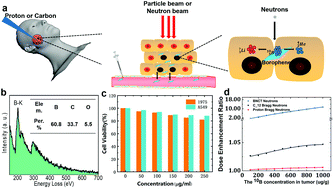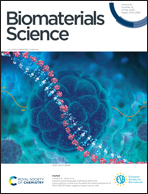The potential role of borophene as a radiosensitizer in boron neutron capture therapy (BNCT) and particle therapy (PT)†
Abstract
The potential role of borophene as a radiosensitizer in PT and BNCT was investigated. Our study focused on two aspects: (1) the synthesis and characterization of borophene nanomaterials; and (2) biocompatibility and dose enhancement. To overcome the limitation of vapor-based technology, we successfully deployed the liquid-phase exfoliation (LPE) method to produce borophene targeting for biomedical applications. Bringing together spatial distribution and dose deposition, the in vitro microdosimetry study was carried out in the presence of borophene. A quantitative study of the dose enhancement ratio (DER) was performed with Monte-Carlo simulation. The synthesized borophene showed good biocompatibility with less than 10% cell death at a concentration of up to 0.2 mg ml−1. The uptake of borophene within individual cells penetrated through cell membranes but outside the nucleus. For proton PT, no significant change in the DER is found. For carbon PT, the DER increases by about 5% as the concentration of 10B reaches 1 mg g−1. For BNCT, a DER of more than 2 can be obtained for a concentration as low as 100 μg g−1. This study lays a foundation for utilizing novel borophene-based nanomaterials as radiosensitizers as well as imaging probes in cancer treatment.



 Please wait while we load your content...
Please wait while we load your content...